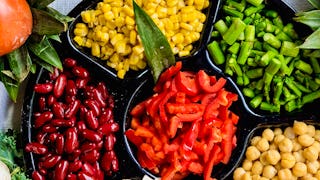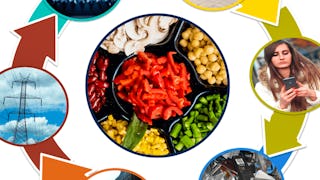This course is an introductory and foundational course on sustainable consumption and health. In the first part of this course, we briefly review definitions of sustainability and the relationship between the three dimensions of sustainability and the UN-Environment Sustainable Environment Goals (SDGs), target and indicators. We then look at frameworks, indicators and footprint requirements to adequately measure sustainability, offering the opportunity to the participants to assess their own carbon and environmental footprint and make recommendation on how to reduce it. We then address the theme of sustainable consumption, looking at our main domains of consumption and at the key conditions to reach sustainable consumption and avoid rebounds effects that tend to reduce the benefits of increased product efficiency. We finally look at "what is good enough" for a given product or activity, in relationship with absolute sustainability and planetary boundaries.

Enjoy unlimited growth with a year of Coursera Plus for $199 (regularly $399). Save now.

Sustainable Consumption and Health
This course is part of Healthy and Sustainable Foods and Products Specialization

Instructor: Olivier Jolliet
4,024 already enrolled
Included with
(18 reviews)
What you'll learn
Analyze health impacts of global trade and of major risk factors
Identify goals and steps for achieving sustainable consumption
Skills you'll gain
Details to know

Add to your LinkedIn profile
See how employees at top companies are mastering in-demand skills

Build your subject-matter expertise
- Learn new concepts from industry experts
- Gain a foundational understanding of a subject or tool
- Develop job-relevant skills with hands-on projects
- Earn a shareable career certificate

There are 3 modules in this course
This course is an introductory and foundational course on sustainable consumption and health. In the first part of this course, we briefly review definitions of sustainability and the relationship between the three dimensions of sustainability and the UN-Environment Sustainable Environment Goals (SDGs), target and indicators. We then look at frameworks, indicators and footprint requirements to adequately measure sustainability, offering the opportunity to the participants to assess their own carbon and environmental footprint and make recommendation on how to reduce it. We then address the theme of sustainable consumption, looking at our main domains of consumption and at the key conditions to reach sustainable consumption and avoid rebounds effects that tend to reduce the benefits of increased product efficiency. We finally look at "what is good enough" for a given product or activity, in relationship with absolute sustainability and planetary boundaries. In the second part focusing on health, we will first identify the main factors affecting health, define DALYs (disability-adjusted life years) as a key metric to measure health burden, and use the rich information made available by the Global Burden of Disease (GBD). We will then use the GBD visualization tool to quantify and compare the respective burdens associated with 70 risks factors and numerous disease causes, in every country of the world and even at the state level for the US. We finally analyze the health impact associated with global trade, evaluating the fraction of the health impacts due to fine particulate in Asia, that are induced by Western consumption.
What's included
7 videos6 readings4 assignments3 discussion prompts
This section focuses looks at the key conditions for sustainable consumption providing an overview of the impacts generated by consumers and by the participants themselves. After establishing our personal carbon footprint, we first relate impacts and costs and identify the critical conditions towards sustainable consumption accounting for rebounds effects. We then discuss how far we have been able to decouple environmental from GDP in different regions of the world. We finally discuss what is good enough and what the product specific targets can be to meet sustainable consumption objectives, not to exceed planetary boundaries.
What's included
8 videos4 readings3 assignments1 discussion prompt
We will now look at the dietary impacts of multiple foods to then analyze trade-offs and targeted change that can bring substantial health and environmental benefits with less than 10% caloric change. We finally address the health and sustainable performances of various diets, looking at disparities between gender, races and diets. Then, equipped with the knowledge and skills you developed throughout our course, you will conclude with two final exercises. First, you will develop a 6-point action plan to feed our planet in a healthy and sustainable way as part of a peer-reviewed assignment. Next,
What's included
6 videos6 readings6 assignments1 peer review2 discussion prompts
Earn a career certificate
Add this credential to your LinkedIn profile, resume, or CV. Share it on social media and in your performance review.
Instructor

Offered by
Explore more from Public Health
 Status: Free Trial
Status: Free TrialUniversity of Michigan
 Status: Free Trial
Status: Free TrialUniversity of Michigan
 Status: Preview
Status: PreviewJohns Hopkins University
 Status: Free
Status: FreeLund University
Why people choose Coursera for their career




Learner reviews
18 reviews
- 5 stars
83.33%
- 4 stars
16.66%
- 3 stars
0%
- 2 stars
0%
- 1 star
0%
Showing 3 of 18
Reviewed on May 18, 2025
The course was detailed and beneficial, but the assignments were challenging.

Open new doors with Coursera Plus
Unlimited access to 10,000+ world-class courses, hands-on projects, and job-ready certificate programs - all included in your subscription
Advance your career with an online degree
Earn a degree from world-class universities - 100% online
Join over 3,400 global companies that choose Coursera for Business
Upskill your employees to excel in the digital economy
Frequently asked questions
To access the course materials, assignments and to earn a Certificate, you will need to purchase the Certificate experience when you enroll in a course. You can try a Free Trial instead, or apply for Financial Aid. The course may offer 'Full Course, No Certificate' instead. This option lets you see all course materials, submit required assessments, and get a final grade. This also means that you will not be able to purchase a Certificate experience.
When you enroll in the course, you get access to all of the courses in the Specialization, and you earn a certificate when you complete the work. Your electronic Certificate will be added to your Accomplishments page - from there, you can print your Certificate or add it to your LinkedIn profile.
Yes. In select learning programs, you can apply for financial aid or a scholarship if you can’t afford the enrollment fee. If fin aid or scholarship is available for your learning program selection, you’ll find a link to apply on the description page.
More questions
Financial aid available,
¹ Some assignments in this course are AI-graded. For these assignments, your data will be used in accordance with Coursera's Privacy Notice.

